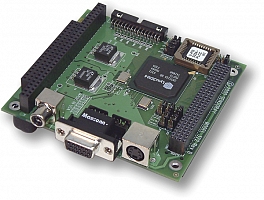| What is the future of PC/104? | |
|---|---|
| In 1996, the PC/104+ standard was introduced by the PC/104 Consortium. This standard added a PCI bus to the existing ISA bus found on PC/104 boards, thus enabling higher performance processors to be used in embedded applications. |

|
|
The PC/104+ standard was readily accepted because of its (arguably) most endearing feature: full compatibility with PC/104. For example, Sensoray's Model 322 CRT/LCD Display Adapter implements a "pure" PC/104+ interface, but it also includes an integrated PC/104 pass-through connector so that PC/104 boards may be freely inserted anywhere in the stack. Since the introduction of the PC/104+ standard, PC/104 boards have lived in harmony with PC/104+ boards in countless embedded systems. The FutureMore recently, the PC99 specification released by Intel and Microsoft has left many engineers wondering if the days of the venerable PC/104 interface are numbered. The specification would seem to make the ISA bus, and by association, the PC/104 bus, relics of the past. This is a matter of great interest to engineers because the imminent demise of PC/104 would force many designers to abandon their foundational PC/104 IP and switch to "pure" PC/104+ platforms for new designs. In a variation of Mark Twain's famous quip, "rumors of the death of PC/104 have been greatly exaggerated!" The majority of today's PC/104 modules are still based on the workhorse ISA bus, with a steady stream of new products being released for both the PC/104 and PC/104+ interface. This trend will continue for the foreseeable future because PC/104 boards are fully compatible with PC/104+ stacks, and just as important, PC/104 boards often cost less and are simpler and more reliable than pure PC/104+ solutions. And despite the popularity of the PCI bus and the impending extinction of ISA on desktop PCs, embedded PC/104+ systems continue to liberally use both bus types: PCI for high speed transfers (e.g., video and storage applications), and ISA for applications that don't require the higher bandwidth, such as analog inputs and digital I/O. SummaryIt is likely that the PC/104+ bus will gain favor with developers as technologies progress and needs change, but the large number of currently available PC/104 products and the industry's willingness to continue to support this technology clearly indicate that PC/104 is here to stay. |
|

